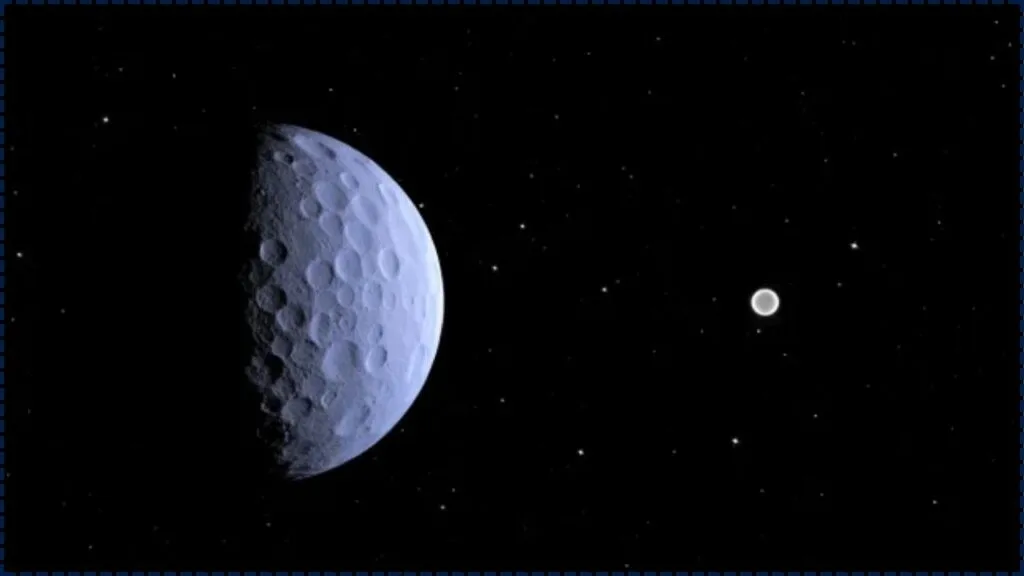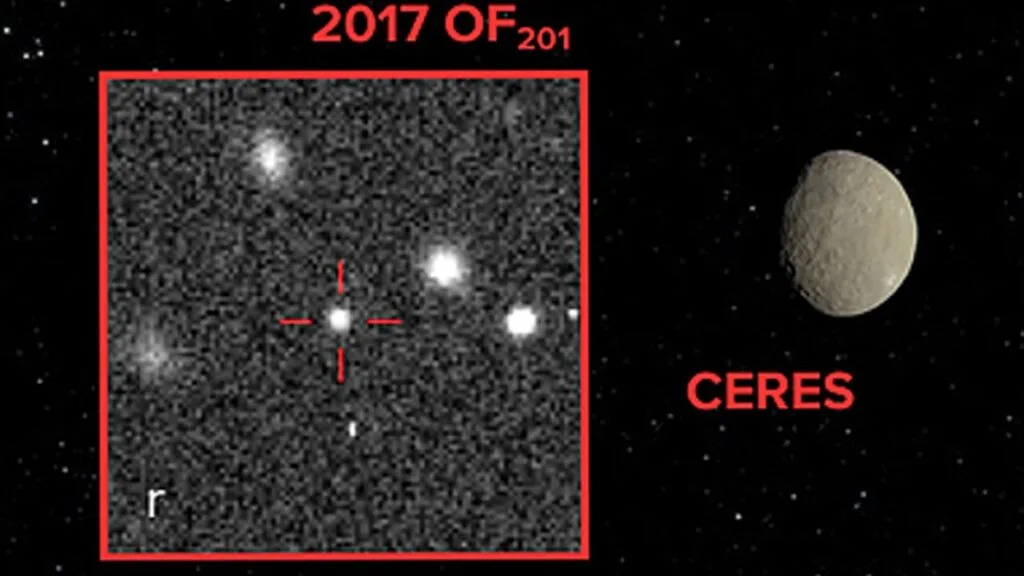In a heartwarming leap for humanity’s curiosity, scientists have unveiled a distant icy traveler, 2017 OF201, potentially our solar system’s newest dwarf planet. Observed through telescopes in Chile and Hawaii, this frosty marvel orbits at the farthest edges of our cosmic neighborhood, capturing the imagination of people worldwide. More than a distant object, it invites us to come together in awe, deepening our shared understanding of how our solar system was born and the gentle forces—like gravitational whispers or the mysteries of dark matter—that shape its boundaries.

Unlike any ordinary rock, 2017 OF201 dances on a grand orbit that takes an astonishing 25,000 years to complete, a journey that speaks to the patience and wonder of the universe. This path offers a precious window into the story of our solar system’s past, hinting at unseen companions waiting to be discovered.
New Dwarf Planet 2017 OF201
| Feature | Details |
|---|---|
| Object Name | 2017 OF201 |
| Estimated Diameter | ~435 miles (700 km) |
| Orbital Distance | Currently 90.5 AU (astronomical units) from the Sun |
| Orbital Period | ~25,000 Earth years |
| Discovery Sites | Observatories in Chile and Hawaii |
| Significance | Potential new dwarf planet; adds insight to outer solar system dynamics |
| Source & Reference | Reuters |
| Official IAU Page | Minor Planet Center MPEC 2025-K47 |
The discovery of 2017 OF201 may mark a significant milestone in the ongoing exploration of our solar system. With its elongated orbit and massive distance from the Sun, this potential dwarf planet challenges our understanding of space dynamics and adds another chapter to the story of how our cosmic neighborhood came to be. As research continues, one thing is certain: the outer solar system still holds many mysteries—and 2017 OF201 may just be the first of many new characters we meet on this interstellar journey.
What Is 2017 OF201 and Why Is It a Big Deal?
This mysterious object is part of a group of icy bodies called trans-Neptunian objects (TNOs). These are celestial bodies that live beyond Neptune, the last official planet in our solar system. The best-known TNO? Pluto, the OG dwarf planet that sparked endless debate about what counts as a planet. Now 2017 OF201 joins the potential lineup of icy misfits challenging what we think we know.
2017 OF201 has the makings of something similarly special. Scientists believe it’s about 435 miles wide, which means it might be large enough to meet the criteria of a dwarf planet. According to the International Astronomical Union (IAU), that means it must:
- Orbit the Sun
- Be spherical or nearly so (due to its own gravity)
- Not have cleared the neighborhood around its orbit
So far, 2017 OF201 checks boxes 1 and 3. Astronomers are still working to confirm whether it qualifies for the second point.

Orbiting in the Deep: Just How Far Is It?
Imagine our Earth, nestled just 1 astronomical unit (AU) from the Sun’s warm embrace, while distant Neptune orbits at about 30 AU. Now picture 2017 OF201, a remarkable celestial traveler, dancing at an astonishing 90.5 AU—three times farther than Neptune, deep in the Kuiper Belt’s mysterious realm. This distant object invites us to marvel at the vastness of our solar system, sparking a shared sense of wonder that unites humanity in our quest to understand the cosmos.
Even more awe-inspiring, 2017 OF201’s orbit stretches to an incredible 1,600 AU at its farthest point, brushing the edges of the Oort Cloud—a distant, icy cradle thought to encircle our solar system. Here, the Sun’s gentle pull fades, and the vastness of interstellar space begins to whisper. This journey reminds us of our small yet meaningful place in the universe, encouraging us to dream big and explore together.
What Makes This Discovery Different?
One of the reasons 2017 OF201 stands out is because it doesn’t match the orbital patterns of other extreme TNOs. You might have heard about Planet Nine, the hypothesized ninth planet thought to be influencing these distant objects.
But 2017 OF201 seems to be doing its own thing. According to a study posted on arXiv.org, its orbit doesn’t fall into the usual clustering that supports the Planet Nine theory. This has prompted some scientists to consider whether other forces, like the gravitational influence of the Milky Way (aka the galactic tide), might be at play. Others even speculate about past star flybys that may have altered the orbit of distant solar system bodies.
That alone makes this icy traveler a fascinating puzzle piece in the solar system’s outer landscape. It could become a linchpin in challenging current solar system formation models and explaining outliers.
Why Do Dwarf Planets Matter?
Great question! Discovering new dwarf planets helps scientists understand the solar system’s formation. These distant objects are often called “fossils of the solar system” because they’ve remained largely unchanged for billions of years.
They can help us:
- Trace back the early history of our solar system
- Study materials from the time of planet formation
- Understand the gravitational forces in the outer solar system
- Challenge and refine existing models about planetary motion
- Provide targets for future robotic missions
Plus, who doesn’t want to find another Pluto-like world? Each discovery is like uncovering a lost piece of our solar heritage, and even if we never visit these icy bodies, they tell a story of cosmic proportions.
How Was 2017 OF201 Discovered?
Astronomers used ground-based telescopes in Hawaii and Chile to track faint movements of faraway objects. The discovery of 2017 OF201 was confirmed after seven years of observations, showing its consistent motion against the backdrop of stars. That’s a long-term commitment, but for astronomers, patience is just part of the job.
Spotting such a distant object isn’t easy. It takes patience, top-tier technology, and a bit of luck. Since it moves so slowly across the sky (remember, it takes 25,000 years to orbit the Sun), you can’t just stumble upon it. The search involved:
- Long-exposure imaging
- Precise positional tracking
- Years of follow-up observations to verify its orbit
- Cross-checking databases to ensure it’s not already catalogued
These observational campaigns often involve collaboration across multiple research institutions and even amateur astronomers contributing valuable data.
Related Links
European Space Agency Sends Classical Music Into Space—Here’s Why
300-Meter Megatsunami Could Devastate US Coast — Scientists Raise Urgent Red Flags
What Happens Next?
Now that 2017 OF201 is on astronomers’ radar, what’s next?
- Size and shape analysis: Further observations using higher-resolution imaging, possibly with space telescopes like the James Webb Space Telescope, to check its shape and determine if it qualifies as a dwarf planet.
- Spectral analysis: To find out what this object is made of. Is it mostly ice? Rock? Something exotic?
- Orbital refinement: Continued tracking will help scientists understand how this object interacts with other bodies and whether its odd orbit tells us something deeper about hidden forces.
- Public naming: The IAU will eventually give this object a proper name. Maybe something from mythology or a name honoring Indigenous astronomy? We’ll have to wait and see.
- Comparative studies: Astronomers will compare this object to other distant bodies to test planetary formation models.
All this research takes time, but the results will paint a more complete picture of our solar system’s outer frontier.
FAQs
Q: Is 2017 OF201 officially a dwarf planet?
A: Not yet. It’s a candidate. Scientists need more data to determine if it’s round enough to qualify.
Q: Could this object be influenced by Planet Nine?
A: Unlikely. Its orbit doesn’t match the clustering used as evidence for Planet Nine.
Q: How far is it from Earth?
A: About 90.5 AU, which is roughly 8.4 billion miles.
Q: Why do we care about these distant objects?
A: They give us clues about how the solar system formed and if there might be more planets out there.












